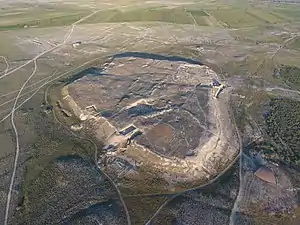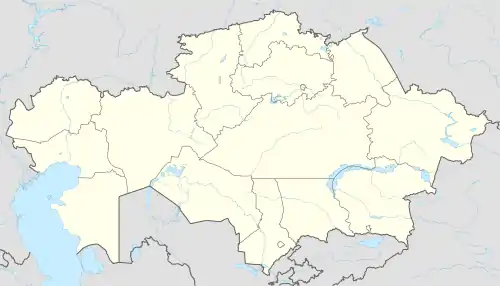Siege of Otrar
The Siege of Otrar took place between December 1219 and February 1220, during the Mongol conquest of the Khwarazmian Empire, at Otrar, a large trading city on the Syr Darya river. Inalchuq, the city's governor, had seized the goods of a Mongol trade caravan the previous year; after more provocations from Inalchuq's liege and ruler of the Khwarazmian Empire, Shah Muhammad II, Genghis Khan launched a full-scale invasion of the empire.[1]
| Siege of Otrar | |||||||
|---|---|---|---|---|---|---|---|
| Part of the Mongol conquest of the Khwarazmian Empire | |||||||
 The remnants of the citadel at Otrar, which was comprehensively destroyed by the Mongols. | |||||||
| |||||||
| Belligerents | |||||||
| Mongol Empire | Khwarazmian Empire | ||||||
| Commanders and leaders | |||||||
| |||||||
| Units involved | |||||||
| City garrison | ||||||
| Strength | |||||||
| Between 70,000 | Between 20,000 and 50,000 | ||||||
| Casualties and losses | |||||||
| Unknown | All | ||||||
 Otrar Location of the siege on a map of modern Kazakhstan | |||||||
The city had been extensively garrisoned and fortified, and the Mongol troops, who arrived in waves, found it difficult to breach the battlements. However, progress was slowly made, and by February, Genghis felt confident enough to detach part of his army and head southwards towards Transoxiana.[2] His sons Chagatai and Ogedai were left behind to continue the siege. Qaracha, the leading general of the city, deserted in February 1220, and soon afterwards, the inner citadel fell. Inalchuq was captured alive, and was executed.[lower-alpha 1]
Muhammad had expected the nomadic invaders to fail in capturing Otrar. Its seizure left the Khwarazmian heartland open to conquest — the Mongols would isolate and capture the great cities of Bukhara, Samarkand, and Gurganj in turn.[4] The Otrar oasis would revive as the Syr Darya shifted in its course; the Khwarazmian citadel, however, would remain abandoned.
Background
Otrar was located on the Syr Darya river, in the middle of an epnoymously named oasis. The city was situated on a main branch of the Silk Road between Transoxiana and China; as such, it was a trading city which most merchants passed through. Like most Khwarazmian cities, it had an inner citadel, which was strongly made, surrounded by outer walls which offered strong protection to the main city. The city, which had first been established in the first century BC as a part of the Kangju state, had been part of several states including the Ummayad Caliphate and the Samanids. Being somewhat isolated from the cities of Ferghana and Transoxiana, such as Bukhara, Khujand and Samarkand, Otrar was more vulnerable to nomad raids from the tribal Kangly and Kipchaks, who lived to the north and east of the oasis.
References
Notes
- Some sources relate that he was executed by having molten metal poured into his orifices; this story, symbolising his greed in seizing the caravans, is almost certainly apocryphal.[3]: 269–272
References
- May, Timothy (2018). "The Mongols outside Mongolia". The Mongol Empire. Edinburgh: Edinburgh University Press. pp. 60–61. ISBN 9780748642373. JSTOR 10.3366/j.ctv1kz4g68.11.
- Jackson, Peter (2017). "The Mongol Westward Advance (1219-53)". The Mongols and the Islamic World : From Conquest to Conversion. Yale University Press.
- McLynn, Frank (2015). Genghis Khan: His Conquests, His Empire, His Legacy. Hachette Books. OCLC 1285130526.
- Juvaini, Ata-Malik (c. 1260). Tarikh-i Jahangushay تاریخ جهانگشای [History of the World Conqueror] (in Persian). Vol. 1. Translated by Andrew Boyle, John.